Citroen BERLINGO 2013.5 2.G Owner's Guide
Manufacturer: CITROEN, Model Year: 2013.5, Model line: BERLINGO, Model: Citroen BERLINGO 2013.5 2.GPages: 240, PDF Size: 12.09 MB
Page 21 of 240
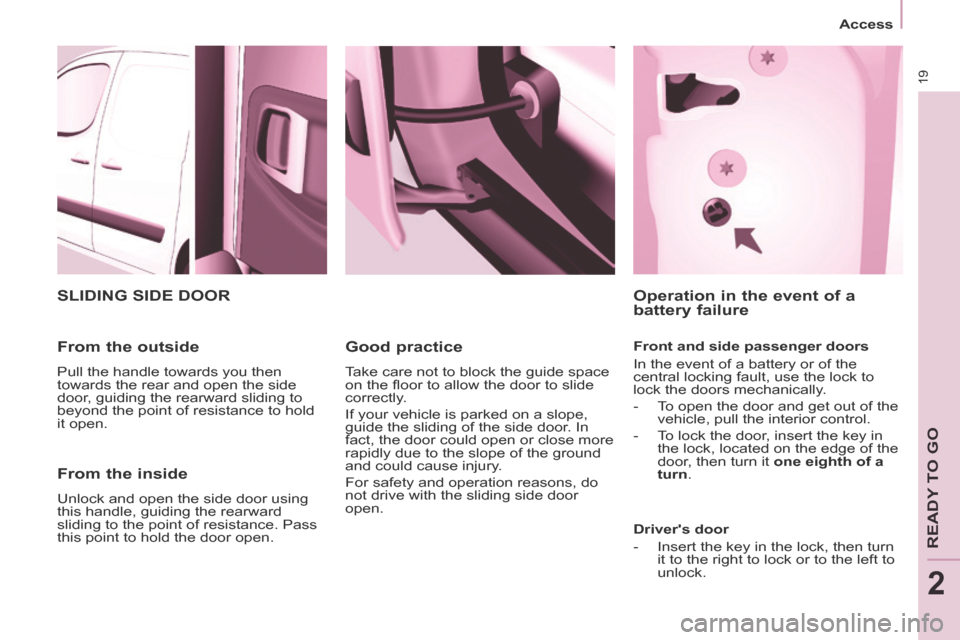
19
Access
READY TO GO
2
From the inside
Unlock and open the side door using
this handle, guiding the rearward
sliding to the point of resistance. Pass
this point to hold the door open.
Good practice
Take care not to block the guide space
on the fl oor to allow the door to slide
correctly.
If your vehicle is parked on a slope,
guide the sliding of the side door. In
fact, the door could open or close more
rapidly due to the slope of the ground
and could cause injury.
For safety and operation reasons, do
not drive with the sliding side door
open.
SLIDING SIDE DOOR
From the outside
Pull the handle towards you then
towards the rear and open the side
door, guiding the rearward sliding to
beyond the point of resistance to hold
it open.
Operation in the event of a
battery failure
Front and side passenger doors
In the event of a battery or of the
central locking fault, use the lock to
lock the doors mechanically.
- To open the door and get out of the vehicle, pull the interior control.
- To lock the door, insert the key in the lock, located on the edge of the
door, then turn it one eighth of a
turn .
Driver's door
- Insert the key in the lock, then turn it to the right to lock or to the left to
unlock.
Page 22 of 240

20
Access
In practice
It is possible to drive with the right-
hand door open to make it easier to
carry long loads. The left-hand door is
kept closed by the distinctive "yellow"
lock, positioned at the base of the door.
This closed door must not be used as
a load retainer.
Driving with the right-hand door open
is a special dispensation. Comply with
the usual safety indications to warn
other drivers.
HINGED REAR DOORS
From outside
Pull the lever to open the right-hand
door.
To close, start with the right-hand door
then close the left-hand door.
To open, pull the handle towards you. The hinged rear doors are
asymmetrical (2/3 - 1/3), with the
smaller door on the right.
They are fi tted with a central lock. With the roof rear fl ap, the rear
bumper has been reinforced to
serve as a footrest when entering
the vehicle.
Page 23 of 240
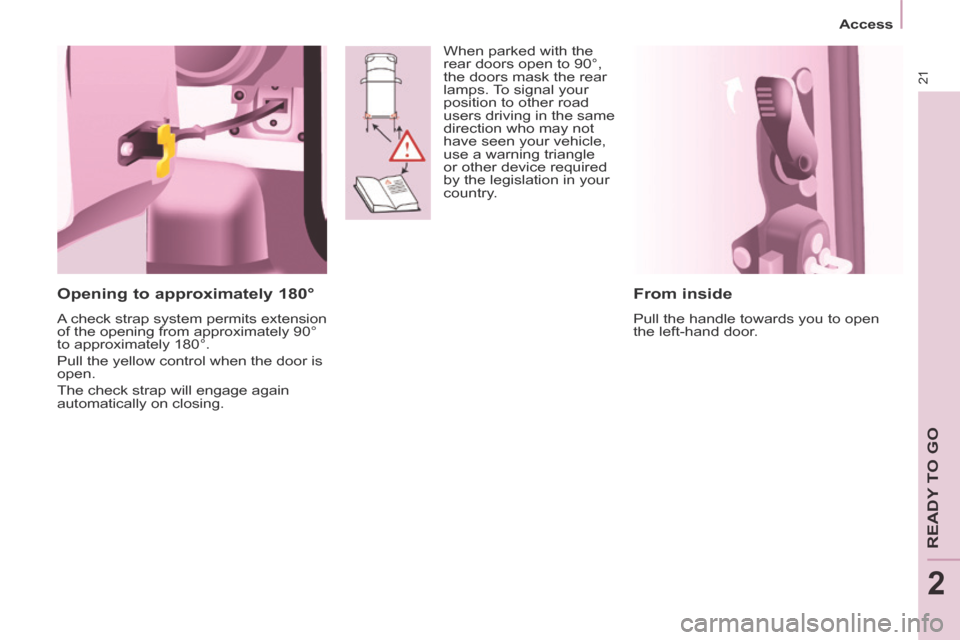
21
Access
READY TO GO
2
From inside
Pull the handle towards you to open
the left-hand door.
Opening to approximately 180°
A check strap system permits extension
of the opening from approximately 90°
to approximately 180°.
Pull the yellow control when the door is
open.
The check strap will engage again
automatically on closing.
When parked with the
rear doors open to 90°,
the doors mask the rear
lamps. To signal your
position to other road
users driving in the same
direction who may not
have seen your vehicle,
use a warning triangle
or other device required
by the legislation in your
country.
Page 24 of 240
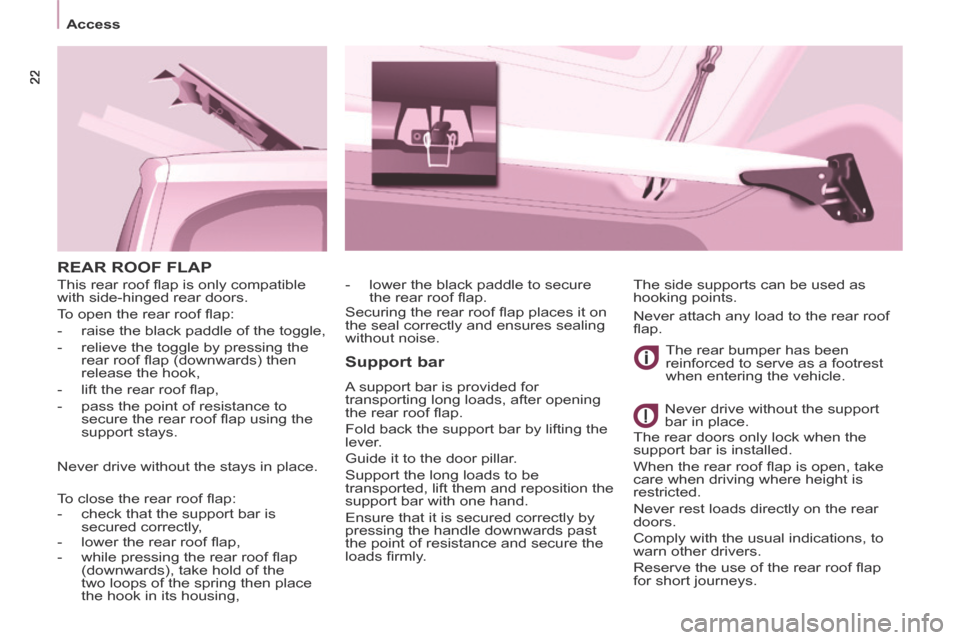
22
Access
REAR ROOF FLAP
Support bar
A support bar is provided for
transporting long loads, after opening
the rear roof fl ap.
Fold back the support bar by lifting the
lever.
Guide it to the door pillar.
Support the long loads to be
transported, lift them and reposition the
support bar with one hand.
Ensure that it is secured correctly by
pressing the handle downwards past
the point of resistance and secure the
loads fi rmly. The rear bumper has been
reinforced to serve as a footrest
when entering the vehicle.
Never drive without the support
bar in place.
The side supports can be used as
hooking points.
- lower the black paddle to secure
the rear roof fl ap.
Securing the rear roof fl ap places it on
the seal correctly and ensures sealing
without noise.
To close the rear roof fl ap:
- check that the support bar is secured correctly,
- lower the rear roof fl ap,
- while pressing the rear roof fl ap (downwards), take hold of the
two loops of the spring then place
the hook in its housing,
This rear roof fl ap is only compatible
with side-hinged rear doors.
To open the rear roof fl ap:
- raise the black paddle of the toggle,
- relieve the toggle by pressing the
rear roof fl ap (downwards) then
release the hook,
- lift the rear roof fl ap,
- pass the point of resistance to secure the rear roof fl ap using the
support stays.
Never drive without the stays in place. Never attach any load to the rear roof
fl ap.
The rear doors only lock when the
support bar is installed.
When the rear roof fl ap is open, take
care when driving where height is
restricted.
Never rest loads directly on the rear
doors.
Comply with the usual indications, to
warn other drivers.
Reserve the use of the rear roof fl ap
for short journeys.
Page 25 of 240

23
Access
READY TO GO
2
TAILGATE
From outside
Locking/unlocking is by means of the
remote control.
To open, press the control below the
trim then raise the tailgate.
A pull strap is available to close the
tailgate in the high position.
Guide the closing of the tailgate to the
balance point of its travel then apply
a fi nal press on the tailgate to close it
fully.
From inside
Emergency control
In the event of a central unlocking
operating fault, this permits unlocking
of the tailgate from the inside.
Insert a small screwdriver in the
opening, between the door and the
fl oor. To unlock the lock, move the
catch to the left then push the tailgate.
Tailgate screen
The opening rear screen allows you to
access the rear of the vehicle directly,
without having to open the tailgate.
Opening
After unlocking the vehicle using the
remote control or the key, press the
control and raise the rear screen to
open it.
Closing
Close the rear screen by pressing
the centre of the glass until it is fully
closed.
The tailgate and tailgate screen cannot
both be open at the same time, to
prevent damage to the screen.
Page 26 of 240

24
Access Driving with the doors locked may
make access to the interior more
diffi cult in an emergency.
CENTRAL LOCKING
Cab and load space Load space
Locking while driving
When the vehicle moves off, as soon
as you reach approximately 6 mph
(10 km/h), the system locks the doors.
The characteristic central locking noise
is heard. The LED in the control switch
on the dashboard central switch panel
comes on.
During the journey, opening a door
results in complete unlocking of the
vehicle.
Anti-intrusion protection
An initial press locks the front
and rear doors, when they
are closed.
A second press unlocks the
vehicle.
The control switch is inactive when
the vehicle has been locked using
the remote control or the key from the
outside. Activating / deactivating the
function
With the ignition on, press
and hold this switch to
activate or deactivate the
function.
Door open warning lamp If this warning lamp comes
on, check that all of your
vehicle's doors are closed
correctly.
Press to lock/unlock the rear
doors without changing the
locking status of the cab.
The doors can still be opened from the
inside.
The control switch LED:
-
fl ashes when the doors are locked with
the vehicle stationary and the engine off,
- comes on when the doors are
locked and from the time the
ignition is switched on.
Page 27 of 240
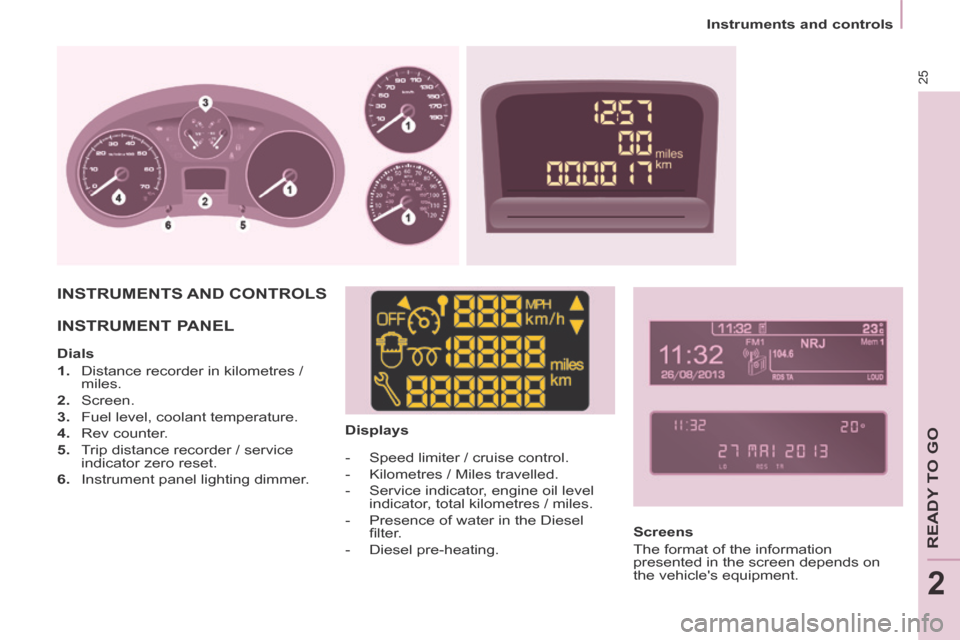
2
Instruments and controls
25
READY TO GO
INSTRUMENTS AND CONTROLS
INSTRUMENT PANEL
Dials
1. Distance recorder in kilometres / miles.
2. Screen.
3. Fuel level, coolant temperature.
4. Rev counter.
5. Trip distance recorder / service indicator zero reset.
6. Instrument panel lighting dimmer. Displays
- Speed limiter / cruise control.
- Kilometres / Miles travelled.
- Service indicator, engine oil level
indicator, total kilometres / miles.
- Presence of water in the Diesel fi lter.
- Diesel pre-heating. Screens
The format of the information
presented in the screen depends on
the vehicle's equipment.
Page 28 of 240
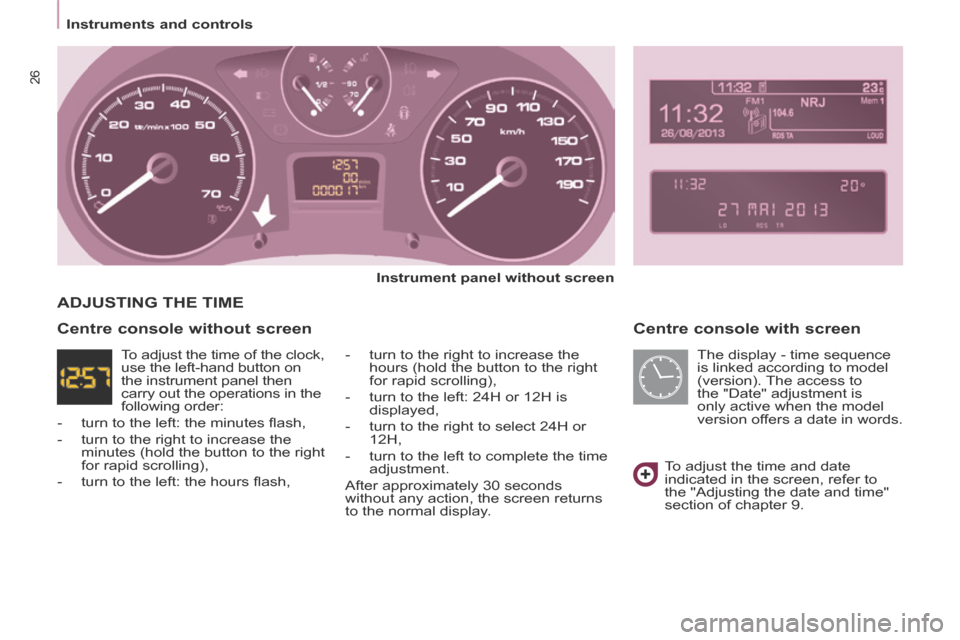
Instruments and controls
26
Centre console with screen
Instrument panel without screen
- turn to the right to increase the hours (hold the button to the right
for rapid scrolling),
- turn to the left: 24H or 12H is displayed,
- turn to the right to select 24H or 12H,
- turn to the left to complete the time adjustment.
After approximately 30 seconds
without any action, the screen returns
to the normal display.
ADJUSTING THE TIME
To adjust the time and date
indicated in the screen, refer to
the "Adjusting the date and time"
section of chapter 9.
Centre console without screen
To adjust the time of the clock,
use the left-hand button on
the instrument panel then
carry out the operations in the
following order:
- turn to the left: the minutes fl ash,
- turn to the right to increase the minutes (hold the button to the right
for rapid scrolling),
- turn to the left: the hours fl ash, The display - time sequence
is linked according to model
(version). The access to
the "Date" adjustment is
only active when the model
version offers a date in words.
Page 29 of 240
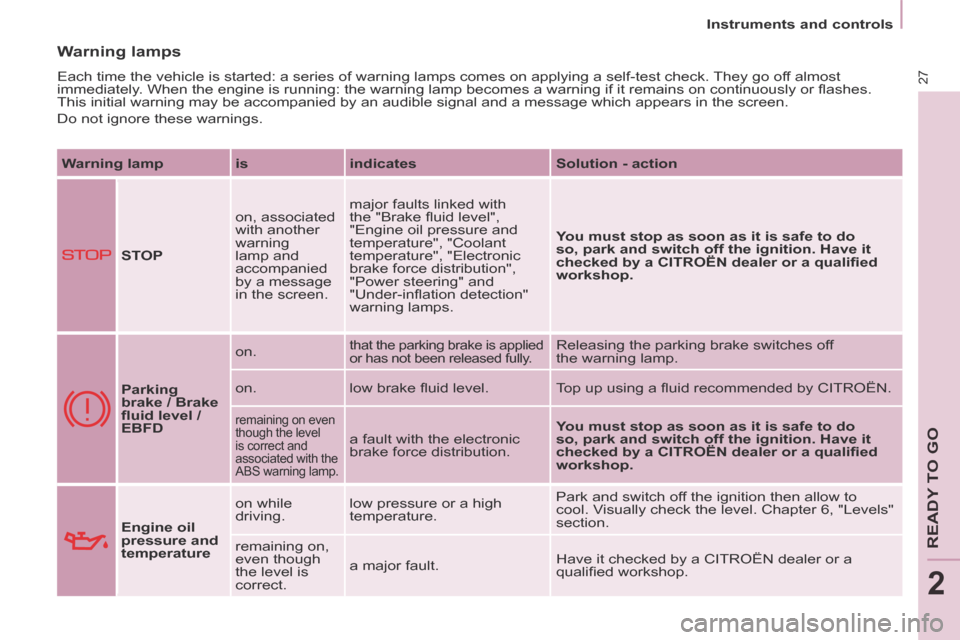
2
Instruments and controls
27
READY TO GO
Warning lamps
Each time the vehicle is started: a series of warning lamps comes on app\
lying a self-test check. They go off almost
immediately. When the engine is running: the warning lamp becomes a warning if it remains on continuously or fl ashes.
This initial warning may be accompanied by an audible signal and a messa\
ge which appears in the screen.
Do not ignore these warnings. Warning lamp is indicates Solution - action
STOP on, associated
with another
warning
lamp and
accompanied
by a message
in the screen. major faults linked with
the "Brake fl uid level",
"Engine oil pressure and
temperature", "Coolant
temperature", "Electronic
brake force distribution",
"Power steering" and
"Under-infl ation detection"
warning lamps.
You must stop as soon as it is safe to do
so, park and switch off the ignition. Have it
checked by a CITROËN dealer or a qualifi ed
workshop.
Parking
brake / Brake
fl uid level /
EBFD on.
that the parking brake is applied
or has not been released fully. Releasing the parking brake switches off
the warning lamp.
on. low brake fl uid level. Top up using a fl uid recommended by CITROËN.
remaining on even
though the level
is correct and
associated with the
ABS warning lamp.
a fault with the electronic
brake force distribution. You must stop as soon as it is safe to do
so, park and switch off the ignition. Have it
checked by a
CITROËN dealer or a qualifi ed
workshop.
Engine oil
pressure and
temperature on while
driving.
low pressure or a high
temperature. Park and switch off the ignition then allow to
cool. Visually check the level. Chapter 6, "Levels"
section.
remaining on,
even though
the level is
correct. a major fault.
Have it checked by a CITROËN dealer or a
qualifi ed workshop.
Page 30 of 240
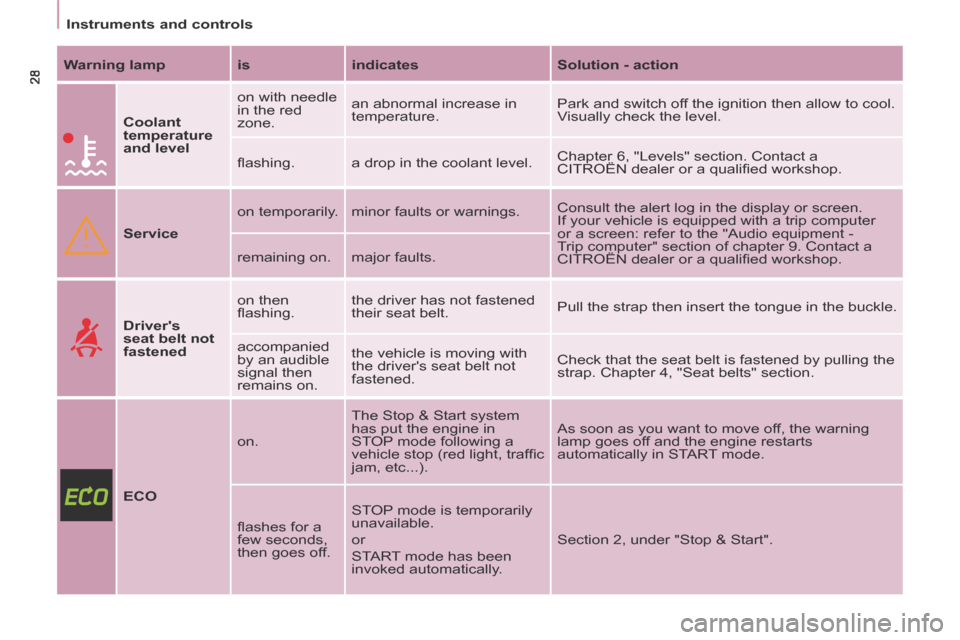
Instruments and controls
28 Warning lamp is indicates Solution - action
Coolant
temperature
and level on with needle
in the red
zone.
an abnormal increase in
temperature.
Park and switch off the ignition then allow to cool.
Visually check the level.
fl ashing. a drop in the coolant level. Chapter 6, "Levels" section. Contact a
CITROËN dealer or a qualifi ed workshop.
Service on temporarily.
minor faults or warnings. Consult the alert log in the display or screen.
If your vehicle is equipped with a trip computer
or a screen: refer to the "Audio equipment -
Trip computer" section of chapter 9. Contact a
CITROËN dealer or a qualifi ed workshop.
remaining on.
major faults.
Driver's
seat belt not
fastened on then
fl ashing.
the driver has not fastened
their seat belt.
Pull the strap then insert the tongue in the buckle.
accompanied
by an audible
signal then
remains on. the vehicle is moving with
the driver's seat belt not
fastened.
Check that the seat belt is fastened by pulling the
strap. Chapter 4, "Seat belts" section.
ECO on.
The Stop & Start system
has put the engine in
STOP mode following a
vehicle stop (red light, traffi c
jam, etc...). As soon as you want to move off, the warning
lamp goes off and the engine restarts
automatically in START mode.
fl ashes for a
few seconds,
then goes off. STOP mode is temporarily
unavailable.
or
START mode has been
invoked automatically.
Section 2, under "Stop & Start".